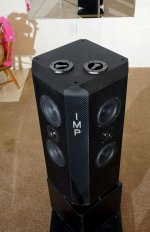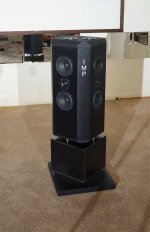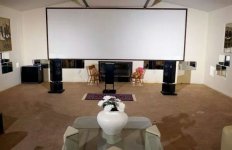A reference to this study would be great. Is it available online to read?
How did you go about measuring IMD when music is used as source?
The papers are on my website. The full procedure is there.
The thing is, live acoustic music hits those peak levels as well. Therefore, all hifi setups should do close to those sound levels cleanly for the playback to come across as realistic, there should not be a separation between the HT and hifi world, in terms of system capability.
I've got no argument with any of that.
Your google search terms are way too broad. I googled for 'earl geddes imd music' and that turned up a presentation Earl gave in Bangkok. Not relevant because of the limiting assumption used that there aren't any frequency dependent non-linearities. I've never seen an amplifier that doesn't have frequency dependent non-linearity.
The papers are on my website. The full procedure is there.
Your website has various papers - to which should I refer?
<edit> Do you have any treatments of distortion (IMD or THD) where you do not make your limiting assumption of no frequency dependent non-linearities?
Last edited:
'Written off' is your own hype. Inapplicable to audio amplifiers for sure though, but that's your choice by making the assumption of no frequency dependent non-linearities.
In your Bangkok presentation you mention that 'some amplifiers' have no frequency dependent non-linearities. Which ones have you found?
In your Bangkok presentation you mention that 'some amplifiers' have no frequency dependent non-linearities. Which ones have you found?
It's in some of the many JJ Johnston PowerPoints.
PowerPoint Presentations from recent (or not so recent) meetings.
Lots of other interesting stuff in those papers.
Great stuff, thanks Kevin.

But the first presentation, 2nd slide has a spelling error!
".. where you're headed" (where you are headed)
not "... where your headed"
Arg, I can't help it, I'm a teacher!

Its neither. We do hear nonlinear distortion and its not generated by the speakers because they're decently designed. That only leaves electronics.
There are assumptions here that perhaps need looking at
1 Are we actually hearing non-linear distortion or are we hearing time domain artifacts that sound like non-linear distortion?
2 That our speakers are competently designed in all respects?
3 Are we hearing a product of non-linear distortion from electronics and linear artifacts from the speaker at certain frequencies?
1 Are we actually hearing non-linear distortion or are we hearing time domain artifacts that sound like non-linear distortion?
Let's look in a little more detail what 'time domain artifacts' might be? Are you talking loudspeaker originated artifacts or ones coming from electronics? If the latter, I'd lump some of them into the 'non-linear distortion' bin - like for example noise modulation effects in S-D DACs.
2 That our speakers are competently designed in all respects?
For which we'd need a falsifiable description for 'competently designed' so we can exclude non-competently designed ones in tests. In any experiment we'd need to control for competence of design and hence such a category description is essential. I've asked in at least one place for a description but so far seen none so is 'competently designed' a useful category to postulate?
3 Are we hearing a product of non-linear distortion from electronics and linear artifacts from the speaker at certain frequencies?
Got an example for how such an effect might arise?
Just as a sidenote and nothing to do with the Behringer. What Beyma writes below about their TPL-150 and compression driver is interesting.Small tweeters just cannot take that much power without excursion and thermal problems.
But how does the TPL-150 compare to a normal compression driver? In Beyma, engineers have made an extended and complete set of measurements to illustrate the superiority of the TPL over a conventional compression driver.
As we can see in the Waterfall measurements, almost all the energy in the TPL-150 has gone away in less than 2 milliseconds. However, if we look the compression driver response, even after 5 milliseconds, the diaphragm is still resonating, blurring the acoustic message.
What about distortion products?
Many different measurements were carried out, including but no limited to harmonic distortion, difference tone distortion, inter-modulation distortion, near field measurements and multi-tone stimulus, all of them at three different power levels, 1W, 7W and 23W AES. We can show many of all these measurements, where always the TPL-150 is clearly superior in terms of distortion.
But one of the most spectacular measurements is the multi-tone response, as it can be more related with the behaviour of the unit with musical signals. Using various sinusoidal signals at the same time, many more inter-related distortion products arise, creating a kind of a “noise floor”, extremely interesting to compare, specially in this case. In the graph, we can clearly see the tremendous quantity of distortion products the compression driver is creating, just with one watt. There is a S/N ratio of less than 45 dB between the main component and the distortion products, along all the band pass of the unit. If we look to the blue trace of the TPL-150, it is incredible how low the distortion is, not even possible to measure it in many frequency regions.
We can also look to the 7W measurement, where it can also be appreciated how the distortion products raises dramatically with power applied in the compression driver, while in the TPL-150, the distortion noise floor is kept proportional to the power applied.
So, not only the distortion is very low in the TPL-150, but also it does not arise dramatically with power applied, as a compression driver does. As a conclusion, this new transducer will be a key component for the next level of professional sound systems of the future, in terms of sonic quality and Live Sound experience.
Haven't tested the TPL-150 myself but heard it in a system where the treble was crystal clear and perceived far more open then many speakers I've experienced with a compression driver. Yes, subjective nonsense I guess.
It may be cultural but Beyma ads are always like this but from what I have seen their products are always a little less than par. Maybe this example is a great product as claimed, I don't know, I just know from past experience that their products don't usually meet up to their hype.
The distortion results are misleading, there is almost a 10 dB difference in sensitivity between the TPL-150 and compression driver.Just as a sidenote and nothing to do with the Behringer. What Beyma writes below about their TPL-150 and compression driver is interesting.
"Many different measurements were carried out, including but no limited to harmonic distortion, difference tone distortion, inter-modulation distortion, near field measurements and multi-tone stimulus, all of them at three different power levels, 1W, 7W and 23W AES."
Haven't tested the TPL-150 myself but heard it in a system where the treble was crystal clear and perceived far more open then many speakers I've experienced with a compression driver. Yes, subjective nonsense I guess.
If the TPL-150 level was boosted by 10 dB, from 1 watt to 10 watts to equal the SPL of the compression driver, the difference in distortion would not be much, if any.
Attachments
I will be demoing these next month. I will report back.
Very nice. Looking forward to your observation!
I don't know how deeply we can go into a comparison with the Behringers, but I will welcome Jason's impressions as the first outside opinion of the success of this approach to stereo reproduction. This was an extremely lucky happenstance of finding Dan Neubecker and having him build these for me. He also contributed a lot of ideas on how to achieve my desired radiation pattern, and of course his legendary speaker building skills - all go to making this the best test of IMT (Image Model Theory) that I could have wished for.
Gary Eickmeier
Gary Eickmeier
both the Orion and the Behringer would not hold up well at higher SPLs. Small tweeters just cannot take that much power without excursion and thermal problems.
Define "higher SPLs" with respect to home application and the power spectrum of audio.
Let's go off on the basic assumption that our max output level is 105db peaks as per THX reference levels... which is louder than most will listen to even with compression driver speakers. Let's assume we want around 117db peaks @ 1m for a rather large
Is it unsafe to say that at 1.4 khz the max SPL needed is going to be 12db less than that, as per the power spectrum of audio content? I'm basing this the nature of pink noise here. So that means our speaker needs to produce about 105db @ 1m @ 1.4 khz. Let's assume its crossover is at 1.4khz and it's a phase-quadrature type (although I use in-phase crossovers personally). That would mean our tweeter is -3db @ 1.4khz or that it essentially needs to produce about 102db @ 1m / 1.4khz.
Let's consider something like the CSS LD25X unit and put it in a guide where far-off-axis response gets redirected forward compared to a flat baffle:
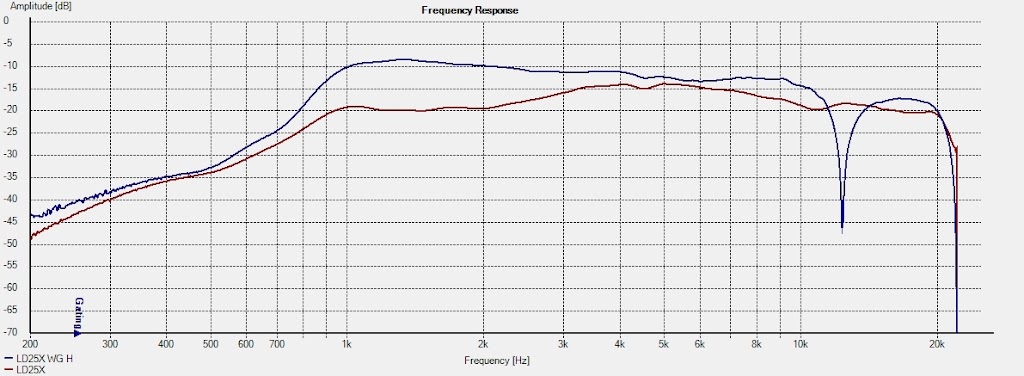
Now let's be conservative and say that a "better" waveguide might give ~4db less boost:
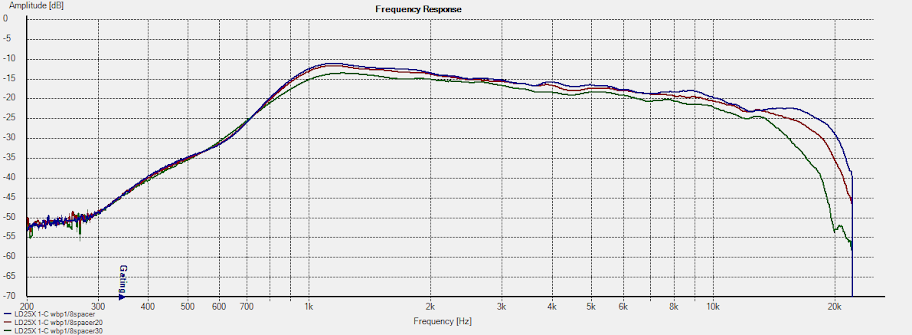
so about 8db of boost @ 1.4khz. Sound fine to you? So that puts our tweeter "SPL" requirement to 94db @ 1m for a speaker hitting peaks of 105db @ 12 feet away
To get this output this particular tweeter needs under 4 watts give or take. In terms of excursion, that's around 0.3 mm one-way. This tweeter lists a klippel-measured xmax of 1.85mm one-way and a nominal power handling of 100W. It seems clear to me that you have headroom to spare, both thermally and excursion-limited, even if specs were to be overstated by as much as 100%.
Last edited:
Your analysis is flawed IMO is several serious ways.
First, it is a mistake to design a transducer based on average levels. Music is transient in nature and the transducers must handle these transients without issue. This means that a flat spectrum, i.e. that of an impulse, is the more reasonable target.
Next the sound power is defined as the square of the spectrum integrated across frequency - linear frequency. That means that there is as much power in a flat spectral signal from 1 kHz to 2 kHz as there is from 0 Hz to 1 kHz. From 1 kHz to 10 kHz there is ten times the power as there is from 0 Hz to 1 kHz.
I don't think that one can argue that tweeters don't need to handle much power because some assumed "power spectrum of audio content" has such a sharp falloff in HF energy.
A compression driver on a waveguide has some 10-20 dB more headroom than a 1" direct radiating tweeter.
First, it is a mistake to design a transducer based on average levels. Music is transient in nature and the transducers must handle these transients without issue. This means that a flat spectrum, i.e. that of an impulse, is the more reasonable target.
Next the sound power is defined as the square of the spectrum integrated across frequency - linear frequency. That means that there is as much power in a flat spectral signal from 1 kHz to 2 kHz as there is from 0 Hz to 1 kHz. From 1 kHz to 10 kHz there is ten times the power as there is from 0 Hz to 1 kHz.
I don't think that one can argue that tweeters don't need to handle much power because some assumed "power spectrum of audio content" has such a sharp falloff in HF energy.
A compression driver on a waveguide has some 10-20 dB more headroom than a 1" direct radiating tweeter.
Last edited:
- Home
- Loudspeakers
- Multi-Way
- Linkwitz Orions beaten by Behringer.... what!!?

